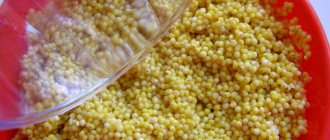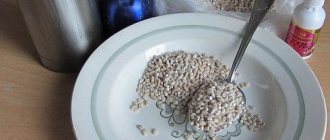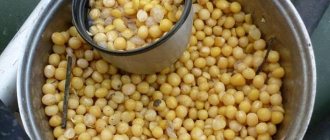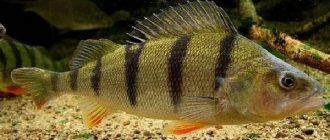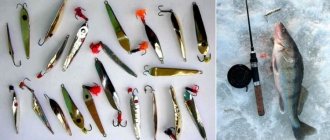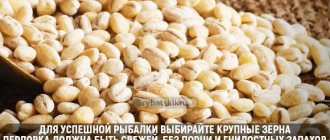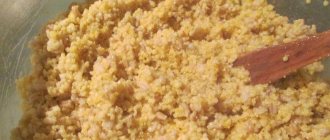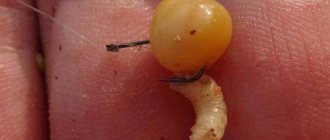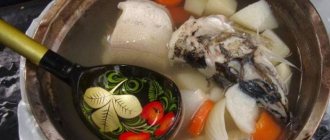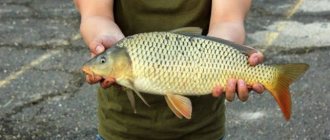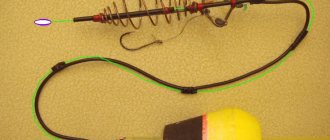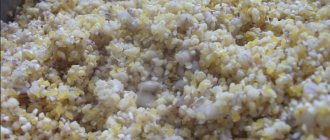Preparing porridge for fishing with a spring
This guide describes methods for preparing porridge from peas, pearl barley, and millet. Recipes are also described on how to prepare and cook corn and semolina porridge for catching bottom fish, such as bream and crucian carp, using a spring - a type of weight feeder. How to make the correct, effective and bite-sensitive tackle is described in the video instructions below.
One of the variants of the classic bottom equipment is considered to be a bottom with a feeder with pea and corn porridge and millet. Recently, it has been actively replaced by feeder tackle, with which the donkey has fundamental differences. One of the options for fishing for donka with a feeder is considered to be a “nipple”. This is the name of the tackle and method of fishing.
Here we will talk about how to cook porridge so that the fish are well-attached and are not indifferent to the bait
Kulesh for fishing
This porridge is prepared from a glass of corn flour, a tablespoon of wheat flour and the same amount of semolina. Mix everything well and add a small amount of liquid. This mixture is transferred to boiling water and cooked over low heat until tender. During the process, it is recommended to add crushed sunflower seeds, sugar and vanillin, and in the fall - salt. This is just the option when you need to find the perfect recipe for how to cook porridge for crucian carp fishing.
“Nipple” – bottom equipment with a spring
The “nipple” fishing method is used to catch peaceful freshwater fish that get their food at the bottom of the reservoir: carp, carp, bream, crucian carp, roach. It works most effectively in bodies of water without current.
The nipple tackle has many modifications, but the principle remains the same.
- The gear is based on a frame feeder (“spring”, “plug”, spoon or “method” type feeder), the weight of which is selected based on the fishing conditions.
- One or more leashes with a hook are mounted on it. The leash material is fishing line or nylon thread with a cross-section of up to 0.14 mm.
- Viscous bait is stuffed into the feeder.
- Hooks, the size of which must correspond to the size of the bait, are equipped with a nozzle or bait (sometimes hair equipment is used) and immersed in the bait.
- A feeder with bait thrown into the water creates a bait spot on the bottom. The fish approaches the spot and begins to suck in food, with which one or more hooks enter its mouth.
Moving away from the spot, the fish either hooks itself, or the bite alarm goes off, and the fisherman hooks the fish. Much depends on the type of equipment. Springs and “method” feeders, for example, are usually mounted on running tackle. The “plug” and spoon are always mounted tightly. When fishing, you can use either a feeder rod or a regular fishing rod with guides, equipped with a bite alarm (bell, bells, electronic bite alarm).
Features of spring fishing
Spring equipment
For effective fishing, it is necessary not only to have porridge that is tasty for fish, but also to properly equip the spring. At the same time, one should take into account the fact that the size of the spring is selected for a specific type of fish. For catching crucian carp, smaller springs are suitable, but for catching bream, and especially carp, you need to choose more massive products. Universal equipment looks like this:
- The main additional element of each rig is a leash with a hook. There can be several of them in this equipment, from 2 to 6 pieces, about 5 cm long. The leashes must be strong and flexible. The main material is braided or nylon thread.
- The size of the hooks is also selected depending on the size of the expected prey. As a rule, these are sizes No. 4-9.
- Sometimes additional weight is used, so the leashes are attached directly to the spring.
- Additional sinkers can weigh from 30 to 50 grams. As a rule, sinkers are attached to the end of the fishing line, and after it several springs are attached with leads attached to them.
- The length of the rod can be about 3.5 meters, with a dough of at least 40 grams.
- The reel must have at least 100 meters of fishing line wound on it, with a thickness of 0.25 to 0.3 mm.
- The moment of a bite can be caught by the tip of the rod, but it is better to use a bite alarm, either simple or electronic.
- The reel is a spinning reel, size 3000-4000, with a baitrunner function.
Types of springs
There are 3 main types of springs, differing in shape, size and installation features. These include:
- The first type is a “donut”, which represents a long spring coiled into a ring (donut shape). As a result of folding, a ring with a diameter of up to 50 mm is obtained, while the spring has a diameter of about 15 mm. One common leash is attached to such a spring, and additional leashes are attached to it.
- The second type is a “harvester”, which has the shape of a conical spring. The leads are attached to the top of the cone. This type of equipment is compact in size and easy to use, so it can be recommended for beginner fishermen.
- The third type is the “crucian carp killer,” which differs in the method of installation. To eliminate the additional weight, 3 springs are attached one after another. Each spring has its own leash with a hook. The distance between them is 12 cm. In some cases, especially when fishing in the current, it is still impossible to do without an additional sinker. It is attached to the very end of the main fishing line.
Spring fishing tips
Baits are selected taking into account many factors, such as the time of year, the preferences of the fish, as well as its type.
You can get good results if you use the following attachments:
- Fresh or canned green peas.
- Fresh or canned corn.
- Maggots.
- Bread crumb.
- Dung or earthworms.
- Insect larvae.
- Regular foam.
Spring with foam
Quite often, fishermen use foam, or rather foam balls mounted on hooks. This especially works when the reservoir has a very muddy bottom. A regular bait will sink into the mud before the fish even discovers it. As for the foam, it will be in the water column due to its buoyancy. Why fish bite on polystyrene foam is not known here; there are so many fishermen, so many opinions. The technique for fishing with foam is as follows:
- To begin with, the fishing point must be fed with porridge.
- A foam ball is placed on each hook, and the tip must be open.
- After this, the tackle is thrown into the desired place.
Fish can accidentally swallow polystyrene foam. There is one more assumption about this. The fish still knows that polystyrene foam is an inedible bait. If so, then it is garbage that needs to be removed. She puts the foam in her mouth and gets hooked. The fact is that the foam ball is always in the fish’s field of vision. Since it is not in one place, but moves to the sides under the influence of the current, this greatly irritates the fish, and it tries to get rid of this irritant. At this moment she gets hooked.
Fishing with a spring in the current
Fishing on the current, no matter what the gear, has its own characteristics. The presence of a current does not guarantee that the equipment will always end up in the same place, since the current moves both the sinker and the spring along the bottom, and with them the leashes with hooks. When feeding the same place, you should take into account the strength of the current, throwing the bait into the same place. Having calculated the place where the bait stopped, you should cast the bait. At the same time, you also need to take into account the fact that the bait is gradually washed away from the place where fishing is carried out. Therefore, you need to regularly add bait.
Fishing in the current requires the angler to:
- Accurate calculation of the weight of the spring so that it is not moved by the current along the bottom.
- Cook the porridge to such a consistency that it can be held in the spring until it touches the bottom, plus another five minutes, but no more.
Fishing in the current requires a lot of experience and knowledge from the fisherman. It is very important to choose the right promising location.
Bait for the feeder
A special requirement for bait used in this fishing method is viscosity. When casting far away, the bait should not crumble when it hits the surface of the water. At the bottom it should be a little dusty, slowly crumbling under the influence of water.
The basis for bait can be porridge (millet, pea, corn (mamalyga)). In addition to the base, it is necessary to add a baking powder to the bait, which is often also a flavoring agent for the bait (sunflower cake, ground sunflower seeds, crushed hemp seed). Some fishermen add a dye to the bait, which can create a cloudy cloud that is noticeable under water from afar (cocoa, yogurt, etc.)
Preliminary preparation of the bait base can take from several minutes to several hours.
Pea porridge
How to properly cook pea porridge? - We answer.
Pea porridge takes the longest to cook.
- First, the peas must be filled with water and left in this form for up to 3 hours.
- Then the peas can be boiled like regular porridge until viscous, or you can “give” them a “steam bath”, and then grind them by passing them through a colander.
- To add viscosity to the porridge, flour or semolina is added to it at the last stage, stirring constantly.
- The finished porridge is transferred to an airtight container and left overnight in the refrigerator.
- You need to take the semolina with you fishing and bring it to a viscous state on the spot.
Video showing the process of preparing pea porridge to the required consistency:
Wheat porridge
Millet can be boiled within 30 minutes.
- Pour one glass of millet into two glasses of water.
- Cook until completely boiled.
- The porridge will turn out slightly undercooked, but fully cooked millet sticks together into dense lumps that even the cake cannot loosen.
- Immediately after cooling, the porridge is ready for use as bait.
The method of preparing wheat is the same as the method of preparing barley groats .
How to cook Mamaliga (corn porridge)
- Corn grits are mixed with wheat flour in a ratio of 3 to 1.
- The mixture is poured out and lightly fried in a frying pan.
- The fried mixture is placed in a container in which water is added little by little, giving the mixture a dough-like appearance. At this stage, you can already add flavoring to the hominy.
- The mixture is packaged in a plastic bag and boiled for 35-40 minutes.
- The mixture is then allowed to cool and only then can it be used.
The resulting basics need to be adapted to catch specific fish.
It, like other baits, porridges, baits, should be stored in the refrigerator. This reduces the chance of possible spoilage of the product and eliminates mold and rot. Naturally, fish will not eat spoiled food.
For catching crucian carp
- You can add sunflower cake to the base (it is better to use millet) at a ratio of 1 to 1
- Knead the resulting mixture thoroughly.
- Add cocoa at the rate of 0.25 to 1 or strawberry yogurt in the same ratio. These two ingredients will simultaneously serve to attract the attention of fish from long distances and give the bait an attractive smell.
- Pack the finished mixture into an airtight container.
There are a number of baits that work well for crucian carp, as well as for other fish, if selected individually.
One of these baits is Traper for crucian carp. Many anglers note a good effect in the process of attaching fish. So we recommend that you also familiarize yourself with purchased baits and how to prepare them for fishing.
For catching bream
- It is better to use pea porridge as a base;
- You need to add corn, buckwheat or barley chaff to the finished mixture in order to slightly loosen the mixture.
- To catch bream, you do not need to use additional flavorings.
For carp fishing
To catch this particular fish, a lot of recipes have been invented with no guarantee that if it works on one body of water, the recipe will certainly work on another. Carp is too cunning and specific a fish to be caught using a template. But if you choose the basics of bait, then it is better to focus on the most high-calorie of them - hominy.
- You need to add a few tablespoons of unrefined sunflower oil to the base.
- Add large fractions, such as corn or pearl grains, to the bait;
- Flavorings must be added while kneading the hominy. “Sweet” flavors such as “strawberry”, “banana”, “pear” work well. There are cool days when carp can only be tempted by additives such as “garlic”, “worm”, “bloodworm”.
Pea porridge
Pea porridge for fishing is prepared in various ways. Some fishermen simply steam a couple of tablespoons of peas in a thermos, add a small amount of sunflower oil when ready and drain in a colander.
But the most effective are boiled peas, which must be sorted out and the poor quality ones rejected. After which the grains are soaked overnight with soda, at the rate of 1 teaspoon of peas per 1 liter of water. Then the peas are placed in a fabric bag, which is secured in the pan so that it does not touch the bottom. In the morning, the peas are poured with the water in which they stood overnight and boiled. Every fifteen minutes the peas must be checked for doneness. The finished peas are drained into a colander and poured onto a hard surface to dry.
To attract fish, milk or sunflower oil is used as flavoring agents.
For more successful fishing, shelled peas are used. Rinse approximately 200 grams of cereal and add water for about three hours. After which the mastyrka is prepared. Boil the peas in the same water in which they were infused. Water covers the grains by about three centimeters. When the peas boil, cover with a lid, reduce heat and cook until tender. The foam that forms during cooking should not be removed - it will disappear on its own. The porridge must be stirred periodically, otherwise the grains may burn. If the grains are already easily crushed, then the lid should be removed and the liquid should be allowed to evaporate. As soon as the water disappears from the surface of the porridge, you should get a homogeneous mass, which is crushed until you get a puree.
For greater attractiveness, add a spoonful of honey or granulated sugar to the mastyrka. Remove the pan from the heat when the porridge begins to squish and release air. Then add about half a glass of semolina, a quarter glass of flour and mix thoroughly. Then add a little more flour and semolina and mix thoroughly, then pour in a small amount of sunflower oil and start making balls, the size of which should correspond to the gear that will be used to catch fish. While sculpting, grease the ball with sunflower oil and place it on the fabric in a special container. The balls must be turned over periodically until they cool completely, otherwise they may become soggy from condensation.
- Monastery. To prepare, you need to boil the split peas until mushy, stirring, add semolina so that it swells completely. Add egg white, a little sunflower oil and five drops of bee honey to the mixture.
- Pea porridge. Peeling peas must be ground in a coffee grinder, pour the resulting flour into water and cook for fifteen minutes. Then add semolina, corn grits and mix everything thoroughly. Make sure it doesn't burn. When the porridge is cooked, you need to add boiled crushed potatoes, a little vegetable or anise oil.
Fishing attachments
The spring is still a summer method of fishing. Therefore, summer baits of plant or artificial origin are used:
- For catching crucian carp - steamed pearl barley, wheat, canned corn;
- For catching bream - boiled pearl barley, canned peas, a ball of foam plastic (in a small current).
- For carp fishing - canned corn, new potatoes, boilies.
But sometimes the fish will not refuse live baits, so it is always advisable to have maggots with you, and you can dig up a worm immediately before or during fishing.
Additional recommendations
Even the most delicious bait will not attract fish to those places where fish never appear. Therefore, it is worth reconnaissance of the reservoir in advance, if possible, measure the depths, examine the bottom.
The last step must be completed. The “nipple” will not work if the layer of silt at the bottom exceeds 30 cm. The bait will simply be pulled into the silt and no fish will simply be able to find it.
You should look for crucian carp sites in pits and tables near thickets of aquatic vegetation. Bream likes to move along edges and dumps. But carp can be anywhere in a body of water, and you can find this fish either with great luck, or by constantly feeding in the same place.
Ingredients used
- Millet as a basis (stable working and accessible to everyone);
- Ground cookies (absolutely any one you have in the kitchen or the cheapest one in the store will do; there are alternatives, but more on that later);
- Powdered milk (turbidity component, there are also alternatives and some reservations);
- Red pepper. (acts as a flavoring and laxative);
- Animal component (optional).
Proportions for winter bait for roach
Keep in mind, these proportions apply if you did not use alternative components.
Adjusted proportions to reflect the changes can be found in the "alternatives for each ingredient" section.
| millet | 65% |
| cookie | 30% |
| dry milk | 4% |
| pepper | 1% |
A little about cooking
Powdered milk, red pepper and cookies are mixed separately before adding to the already cooked porridge. This will be a little more convenient.
The cooking process itself is extremely simple. Let's assume you already know how to cook millet. If not, then I remind you, the link is at the very beginning. Cookies are easily crushed with a mortar or meat grinder. For particularly thorough grinding, use a coffee grinder; it will take longer but will be of better quality.
This bait is mixed at home and strictly the day before fishing. As a tip, even store-bought winter roach bait is much more convenient to prepare in advance at home. In the cold, it is extremely inconvenient to moisturize, and sometimes it is simply unrealistic.
A little recommendation
Not only good bait contributes to rich catches, it is equally, if not more important, to understand WHERE to fish. To simplify the search for a catchable place, we have developed a map with reports where it is possible to apply a filter by type of fish. For example, here - “Reports only on roaches”.
What can you replace each of the ingredients with?
Alternative options for winter bait for roach. Adjust proportions accordingly.
Pshenka
Millet can be replaced with corn grits . Roach is a well-known lover of corn, so even in winter it is a completely working component in bait.
We cook the cereal in the same way as millet. 8 minutes and subsequent filtration.
In proportions, it is possible to save a little on cookies, since the base itself is slightly smaller in diameter of its fractions.
| corn grits | 75% |
| ground biscuits | 20% |
| dry milk | 4% |
| red pepper | 1% |
Cookie
A good alternative to ground liver would be breadcrumbs . You can also grind a dried loaf , but this is possible if you prepare it in advance.
The proportions will be the same as above, only adjusted for the base used (millet/corn grits).
Powdered milk
The use of dairy products in winter to feed roaches is no longer new. There is even such a specific winter bait as cow's udder.
You can replace powdered milk with infant formula , in this case the proportions do not change.
But the dusting effect can be achieved not only with milk, for example, semolina and the proportions will be as follows.
| millet or corn grits | 65% or 75% |
| cookies or crackers | 25% or 15% |
| semolina | 9% |
| red pepper | 1% |
When using semolina, the bait will be a little more consolidated, its activity in the water is somewhat lower, but for roaches this is not critical.
Red pepper
Red pepper is quite an important additive; in addition to being an irritant, it acts as a laxative and will not allow the roach to get full quickly.
It can be replaced with ground black pepper , but you will need a little more of it. It doesn’t make much sense to write percentages, just add 2 times more than red.
You can also add fresh garlic . At the rate of 2 cloves per 1 kg of mixture. Finely grated garlic is added to the already cooked porridge and mixed thoroughly.
Millet nozzle
Making a catch bait from millet is interesting because it is not necessary to cook the grain. But grains and other ingredients must first be prepared:
- grind the millet with a coffee grinder;
- pass the bread through a meat grinder;
- grate the cheese.
Mix the ingredients, add a little water to knead. The result is a soft dough from which you can tear off pieces and make small balls for the nozzle.
Millet bait for carp fish
A cooking option could be adding chopped corn or fried seeds to the ground millet. Using semolina, wheat flour and water, form an elastic dough, which must be left for 10-15 minutes. The mass emits a pleasant smell of seeds; no other flavorings are required.
If everything is done correctly, the millet-based dough is easy to roll and firmly threaded onto a hook. The attachments are designed for large specimens.
Millet nozzle
Another cooking option is based on complete boiling of millet grains, mixing with flour and other ingredients.
Baits based on millet flour or boiled grains are successfully used for fishing with donka and float tackle. Delivery by boat to the fishing spot.
Adjustments for current
If the current is weak, then it makes no sense to make any changes when using a special feeder. But if the flow is strong enough, then the bait needs to be heavier.
The simplest, but not accessible to everyone, method is to add soil ( earth or clay ). Add to any of the resulting mixtures in a 1 to 1 .
The second way is to increase the stickiness of the mixture. Here you will have to do a little magic with cooking the porridge, adding additional ingredients and changing the proportions.
- We cook the porridge in the same way, but no longer filter it.
- We include a little wheat or rye flour.
- We give up milk in favor of semolina and slightly increase its ratio to the base.
Dough-like porridges for fishing
Most often, anglers use the classic dough recipe. It is mixed with berry juice or milk. Any porridge, raw egg white, honey, garlic, valerian, valocordin, vanilla and all kinds of oils in minimal quantities are added to it. For one hundred grams of nozzle, two drops of flavoring will be enough. In large doses, on the contrary, they will scare away any fish.
The non-classical version of the test is also in demand among fishermen. To prepare it, take about half a glass of cooked peas and grind them into puree. The same amount of cooked oatmeal is added to it. Next, gradually add wheat flour and knead the dough. After this, roll it into a pancake and fry it in vegetable oil for several minutes. Knead in your hands and put back into the frying pan. The procedure is repeated several times.
Bait for roaches in winter
You can feed fish in different ways. It all depends on desire, free time and opportunity. Those who live near a reservoir can not feed the fish, but feed them, set the underwater table, lowering more than one pan of porridge into the hole and waiting for several days for the “normal” fish to arrive.
The other extreme is when winter roach and other fish are not fed at all, or only bloodworms, crumbled loaves of bread, soaked breadcrumbs, semolina, etc. are used for this purpose, poured periodically into the hole. But the feeder lover is used to using bait always and everywhere. For many, the process of choosing/preparing bait is already part of fishing.
To catch roaches well in winter, you won’t just pour bloodworms into the hole. It will attract perch or ruff, but not roach. She needs grains, seeds, baked goods and a mixture of them!
When fishing from ice in winter, bait is used in different ways:
- Balls made from a moistened (viscous) mixture are lowered into the hole (fishing depth 1-2 m);
- Pour dry into a hole (depth 1-2m);
- They lower it to the bottom with a feeder, such as a cone (dump truck), or use feeder equipment when fishing from ice (fishing depth more than 1.5 m and in the presence of a current).
At shallow fishing depths (weak currents), 1-2 m of bait are made into balls and lowered into the hole. After this, periodically add a drier mixture. This creates a nutrient plume in the water column, and a bait spot at the bottom. If there is a current, then they feed one hole and fish it a meter away on the bottom hole downstream.
Barley porridge (millet, pea) - the best ingredients for baiting roaches
Barley groats are, perhaps, second only to crackers in popularity in winter bait. This cereal is inexpensive and effective. Excellent for attracting roaches and breams. Most often, barley groats are boiled, then dry ingredients are added to it: crackers, ground grains and cereals.
The same with millet. Properly cooking millet for bait is not difficult. Its cost is low, and almost all white fish love it.
Pea porridge is another effective ingredient. In many reservoirs, fish are accustomed to peas, and are caught well on peas.
We previously published two popular recipes. One of them, a recipe for bait with peas for catching winter roach, is similar to the one described below. You just have to try both or choose based on your own experience.
Spring porridge recipes for various types of fish
Porridge for crucian carp
Crucian carp, found in many domestic reservoirs, is the most popular prey. Corn porridge prepared in accordance with the following recipe is well suited for catching it:
- Pour corn kernels into a pan of water and add one teaspoon of granulated sugar.
- The corn is cooked for 2 hours; it should be stirred periodically with a spoon.
- The resulting mass should be cooled to a comfortable temperature, then passed through a meat grinder and mixed with cat or dog food.
- You can use a small amount of anise seeds, vanillin or grated garlic as a flavoring.
Porridge for carp
The spring is very often used if the main target of fishing is carp; in this case, you can prepare the following porridge:
- 800g of dry peas are poured into the pan; they need to be cooked until a homogeneous liquid mass is formed.
- While the mass is cooling, take one bag of fried sunflower seeds and pass through a meat grinder.
- Add 400g of semolina in small portions to the cooled pea mixture, while simultaneously stirring the mixture with a spoon.
- Mixing should be continued until the mass in its structure begins to resemble hard dough; immediately after this, crushed seeds are poured into it.
- The porridge is thoroughly mixed again.
Porridge for bream
There are various options for porridge designed for catching bream, but the most effective bait is prepared according to the following recipe:
- Three full glasses of water are poured into the pan, after which it is brought to a boil.
- Several glasses of pearl barley are poured into boiling water; cooking should be accompanied by constant stirring and continue until the cereal swells.
- One glass of millet, a tablespoon of sunflower oil and a small amount of vanillin are added to the composition.
- Cooking continues until the millet absorbs the remaining water: this will be indicated by the appearance of bubbling holes on the surface.
- The pan is removed from the heat and covered with a lid; The porridge must be allowed to sit for half an hour.
- After the specified period has expired, the bait is transferred to a clean pan, one glass of semolina and two glasses of barley and corn grits are added to it.
- The mass is thoroughly mixed, after which an effective bait for catching bream with a spring is ready.
Recipe for the best bait for roach:
- Cook barley porridge. 2 cups of cereal per 1.25 liters of water. Cook over low heat until the water boils away (barley porridge can be replaced with cooked millet or pea porridge);
- Pour 1 cup of breadcrumbs into the hot cooked porridge (this is how the breadcrumbs are steamed);
- Add ½ cup of fresh ground roasted seeds there;
- ½ cup fresh ground flour;
- ½ cup ground oatmeal;
- 1 cup of ready-made factory bait (optional). You can take any one, but preferably a winter one, darkened.
Agree, minimum components and time spent. The result: a small but persistent aroma, the presence of dusting and nutritional fractions.
This mixture is suitable for feeders and hand feeding. The bait turns out crumbly. Dry additives absorb water from the porridge.
This dryish mixture is suitable for catching roach with a feeder. If you need to make balls, you can add water.
Video from Anton Zanizdra on how to mix such winter bait:
Recipes for the best porridges for spring
Millet porridge for fishing on a nipple
Millet is one of the most popular cereals, since it is a universal bait that bites most species of fish; Most often it is used for catching tench, carp, roach or crucian carp.
The recipe is quite simple:
- Pour a glass of water into a container and keep it over low heat until it boils.
- Pour several cups of cereal into boiling water.
- The cooking process takes no more than 15 minutes, during which time the porridge must be constantly stirred with a spoon.
- After the specified period of time, remove the container from the heat and allow the millet to settle a little.
- It is allowed to add a small amount of feed to improve viscosity.
Pea porridge for spring fishing
The recipe for pea porridge is also quite simple, but the cooking process itself is more expensive. The result will be a universal bait that can interest many species of fish.
You can prepare it in the following way:
- Pour a liter of water into a container and add 200g of peas, then put it on the stove and reduce the heat to low.
- Let the mixture come to a boil, stirring it to avoid sticking to the pan.
- After boiling, you need to carefully remove the resulting foam and leave the mixture on low heat for another 10 minutes.
- After 10 minutes, you can turn up the heat, but cover the porridge with a lid.
- After 5 minutes, no more than half a teaspoon of baking soda is added to the composition, after which the porridge must be thoroughly mixed to evenly distribute this component.
- If all the described actions are followed, the peas should turn into a liquid mass, to which 100 grams of millet cereal is added.
- After 10 minutes of cooking, add one teaspoon of granulated sugar and a third of a teaspoon of table salt. This will make the bait more appetizing, which will increase the chances of a catch.
- If desired, you can add a small amount of sunflower cake to the composition.
Mamalyga (corn porridge) for fishing with a spring
Mamalyga is a corn porridge that is easy to prepare and can provide an active bite; It is usually used when fishing for tench, ide, crucian carp, roach or rudd.
The recipe is detailed below:
- Initially, you will need to take a hot frying pan and fry 300g of corn flour in it, placing it on high heat. Frying should take no more than 3 minutes; the flour should be stirred constantly.
- At the second stage, you can add 100g of wheat flour and heat the mixture for a few more minutes.
- The fried flour is gradually poured with water; this can only be done by first reducing the heat to a minimum.
- After 10 minutes, the porridge should become thick and viscous; now, at your discretion, you can add sunflower cake or a very small amount of vanillin.
- The porridge should be removed from the heat and allowed to cool slightly, then divided into two equal portions and placed in plastic bags that are sealed tightly.
- The bags are placed in a pan, into which a liter of water is poured, after which the bait is cooked for half an hour.
- Corn porridge can be left in the same container overnight and the water drained in the morning. The resulting bait, depending on its consistency, can be cut with a knife or formed into balls, which are then placed in a spring.
Porridge from mixed feed for spring fishing
This bait is based on a mixture of raw materials from different grain crops; special attention must be paid to the preparation process, otherwise you will end up with a liquid porridge, which the current will quickly wash out of the tackle.
It can be used for catching rudd, crucian carp or crucian carp; The recipe is given below:
- You will first need to prepare the potatoes by boiling them in their skins.
- Pour 2 liters of water into a saucepan, put it on the fire and wait until it boils.
- Add 0.5 kg of feed and cook for 5-10 minutes, continuously stirring the mixture.
- Add crumb taken from a loaf of rye bread to the composition.
- Select the two largest potatoes, crush them to a puree and add to the composition.
- Pour one tablespoon of sunflower oil into the porridge, then mix it thoroughly.
- A very small amount of vanillin can be used as an additional ingredient.
Semolina porridge with rolled oats on a spring
Another universal bait is semolina porridge with the addition of rolled oats; it attracts all types of fish that can distinguish odors in the water.
To prepare it, it is recommended to use the following instructions:
- Take two identical glasses - fill one halfway with semolina, and pour water into the other so that its level is a few millimeters higher.
- Water is poured into the pan and brought to a boil.
- Oatmeal is poured into boiling water; the proportion must be observed: one teaspoon for every half glass of water.
- One teaspoon of granulated sugar is added, after which the mixture is thoroughly mixed.
- You need to wait until white foam appears on the surface, after which you can begin to gradually add the pre-prepared semolina, while still stirring the porridge.
- After absorbing the liquid, the mass should be carefully pressed down on top, the container should be wrapped in a towel or blanket and the porridge should be allowed to settle for 15 minutes.
- After the specified period, you should rinse the mass again so that no distinguishable fractions of the cereal remain in it.
- A small amount of anise oil can be used as an aromatic additive.
Dry bait for winter (pour into the hole)
The following recipe for roach contains dry ingredients. No cooking. Suitable for fishing at shallow depths of 1-2m. If desired, you can moisten and make balls or put in a feeder (for greater depth and flow).
It has been noticed that the roach moves throughout the entire water column and responds well to a cloud of bait in the water. In winter, the mixture is poured into a plastic bottle and periodically poured into a hole or feeder. In water it gets wet, large particles settle and hold fish, small particles float and attract.
One 1.5 liter plastic bottle with bait is enough for a day of fishing in winter
Composition from Yuri Teterin:
- Breadcrumbs – 5 parts.
- Ground cookies , gingerbreads, cakes, biscuits, etc. – 2 parts.
- Semolina – 1.5 parts. Semolina is considered by many to be one of the main ingredients for roach. It has a delicate aroma, creates turbidity in the water and, if necessary, holds the components together when soaking.
- Barley groats – 1 part. Larger particles than semolina.
- Roasted ground seeds – 1 part. They give off flavor and, thanks to the husk, float well.
- Ground bran – 1 part. Nutrient fraction. Create an attractive cloud in the water.
- cat food – 1 part. Recommended for roach in winter. Gives aroma.
Some anglers attract fish only with semolina, raw millet or ground seeds, pouring them into the hole (when fishing at shallow depths). In water, semolina and seeds get wet and drown. The jig is usually thrown into the next hole downstream.
This is how Yuri Teterin mixes the bait described above for roach. Video:
Recipe
There are a lot of tips and recipes for making hominy, but the most correct recipe for it must meet the following requirements:
- The porridge should be dense so that it can be cut, stick a hook into it and it will not dissolve in water.
- It should not burn or stain the pan during cooking.
- Hominy can be additionally flavored to make it more attractive for a specific type of fish and in a given season.
Whole corn kernels and corn hominy are very different in structure. The advantage of well-cooked porridge is that it is easy to roll it into balls and place it on a hook or hair or throw it for feeding.
For hominy bait for fishing we will need:
- corn flour (you can buy ready-made in the store, or you can grind corn grits in a coffee grinder);
- wheat flour;
- two polyethylene bags;
- flavoring products;
- water;
- pot;
After cooking, the hominy needs to sit for 1-2 hours, so it needs to be prepared in advance.
Before cooking, a mixture of two types of flour is thoroughly fried in a hot frying pan. This significantly enhances its taste and smell. The mixture is prepared in a ratio of 1:3 (three corn flour is added to one part of wheat flour). Mix everything thoroughly. Wheat flour in the mixture is needed to increase its stickiness. You can experiment with other types of flour, such as soy, oatmeal or pea.
Pour cold boiled water into the mixture gradually, in small portions, to form a thick paste-like mass of dough. You can add a little butter to the dough to make it more elastic. It is best to mix everything by hand.
Bait flavoring:
At this time, add flavorings to the porridge (decide on the direction of flavoring and do not mix fruits with spices, flavor only with one type of taste):
- jam;
- honey;
- sugar;
- poppy;
- vanilla;
- garlic;
- cinnamon or other aromatic seasonings;
Pour the finished mixture of two types of flour into a plastic bag and tie it tightly. We put this package into another package. We also tie this bag tightly. This way we will protect the bait from water in the event of a rupture of the first package. You can use fabric bags rather than plastic bags, but in this case the taste of the porridge will not be as bright and attractive.
Place the bags in a pan of boiling water and cook for 20-40 minutes. Then we let it simmer directly in a pan of water for half an hour. And we take the bait directly in the bag with us on a fishing trip. If you prepared the bait the night before, wrap it in cotton cloth overnight. In a bag or newspaper it will suffocate and lose its attractive aroma. Already at the fishing spot, unwrap the ball and scrape off the dried crust from it. You will have fresh aromatic bait left, and additional food in the form of dried porridge crusts will get into the water.
Right while fishing, we open our bag and cut the lump of hominy into pieces or roll it into balls. It is more convenient to do this with wet hands - this way the hominy becomes more elastic. The porridge prepared according to this simple recipe turns out to be quite dense and will not fall off the hook even during a long cast, and also has a strong attractive aroma.
Such a hominy ball, once in the water, will stay in the water for about 20-25 minutes and only then fly off the hook.
Recipes for making boilies with your own hands from flour and other household supplies are in the next article.
A feeder guide to rigging a rod and creating a rig for beginners.
Prepare thoroughly for your upcoming fishing trip. Cook delicious corn bait and a successful catch will not be long in coming. Share in the comments your experience of preparing and fishing with mamalyga corn bait.
What bait for roach in cold water?
The following composition does not contain, perhaps, the most important thing for any mixture - crackers. Why not? They can be completely replaced with porridge. Believe me, a roach has never swam past in winter. This composition is also suitable for winter and summer.
Recipe from Antonovich:
- Boiled barley or wheat porridge. Take 1 cup of cereal to 2 cups of water. The porridge should be semi-dry. When cooked, leave to cool. This way the cereal will absorb all the water.
- ½ cup ground roasted seeds.
- 1 tbsp. fresh popcorn (can be replaced with seeds).
- 1/2 tbsp. ground flax or hemp seeds. Pre-fry. They give aroma and activate the bite.
- ½ tbsp. coconut flakes. It gives off an aroma and floats up well, attracting not only roaches.
- ½ tbsp. wheat flour.
Oatmeal Recipes
- Flakes. Oatmeal is cooked in milk without adding sugar or salt until half cooked. Then several petals are placed on the hook.
- Semolina with oatmeal. This porridge is excellent for catching white fish - it stays on the hook for a long time and is not washed away by the current. You need to take two identical glasses. One of them needs to be filled with semolina, and in the second, pour water a couple of millimeters higher than the amount of semolina in the first glass. Water is put on fire. After boiling, you need to add oatmeal and sugar (for 1/2 cup of water, take a tablespoon of oatmeal and a teaspoon of sugar). After a short boil, foam forms on the surface. Now you need to add semolina to the porridge in an even stream, stirring continuously. Remove the porridge from the heat and stir until the dry grains disappear. After this, crush the mass into a tight ball, wrap it with a towel and leave for fifteen minutes. Moisten your fingers with unrefined vegetable oil, remove the dough and add anise oil.
The simplest bait in composition, but using tangerine peel
Everyone knows that in cold water it is customary to use a minimum of aromas. Natural smells should also be enough. But many fishermen do not agree with this statement and are not afraid of even very unusual aromas.
There is a simple but effective bait recipe for roaches:
- Breadcrumbs - 2 parts.
- Ground roasted sunflower seeds – 1 part.
- Grated tangerine zest – ½ part (I’ve heard that tangerine zest is good for roach, but bad for bream!)
For roaches in winter, cucumber lotion, vanilla, coriander and cinnamon are also used in bait instead of the smell of zest. Here you need to build on your own experience.
Another video of preparing bait mixture:
Leave comments and write your recipes.
See useful articles:
Winter bait for bream is a popular recipe and theory for selecting a bait mixture for bream.
Preparing bait for roach - practical advice on fishing tactics, selection of components for feeding.
Mega catchable pearl barley mixture for catching peaceful fish
To catch peaceful fish using float or bottom gear, in order to attract them to the fishing site, fishermen mainly use various kinds of mixtures and porridges. One of the most popular is pearl barley. Pearl barley, despite the fact that it is an easy-to-prepare cereal, is at the same time very effective, both as one of the additions to bait, as well as a self-sufficient bait mixture and as an independent attachment.
Fishermen often use various types of porridge for bait.
Most often, for fishing with bottom gear, it is necessary to feed a promising area with crumbly, fine store-bought bait, and during fishing, balls of bait made with one’s own hands are thrown in small portions. It would not be a bad idea to add a certain amount of complementary food to the store-bought bait during the starting feeding.
Porridge for the feeder
Very often they use porridge on a feeder for fishing. But it will not be a nozzle. This gruel is a kind of bait, which is delivered to the required place using a sinker.
A mixture of oat and millet cereals gives an excellent effect. They are taken in a ratio of one to three and filled with water, which should be twice as much. After a few minutes of cooking, toasted crushed sunflower seeds and pieces of poppy seed are added to the mixture, but its dust is also perfect. Cook the porridge until softened, cover with a lid and let it brew for an hour. After this, grease with vegetable oil and transfer to a bowl. Under no circumstances should you salt!
In closed reservoirs, it is most effective to use millet porridge. You need to prepare it according to the above recipe. Only during cooking add a tablespoon of softened semolina.
Pearl barley is also an excellent bait. A glass of cereal is poured into a thermos and filled with boiling water. After four hours, the swollen grains are passed through a meat grinder and mixed with crushed toasted sunflower seeds and maca dust.
There is also a cheap fishing porridge recipe that can be used for feeder sinkers. You will need two handfuls of oatmeal and a crumb of bread. They need to be mixed in a small amount of water and kneaded to the consistency of a thick dough. After this, the finished mass is placed in a feeder, and a little millet porridge with flavorings is sprinkled on top.
Components of catchable pearl barley mixture
This mixture should be prepared using steamed pearl barley . However, pearl barley does not need to be steamed for all three hours to bring it to a soft state. To prepare this pearl barley mixture directly, you need to steam the cereal for 1.5-2 hours so that the grains remain slightly hard on the inside, but soft on the outside.
Such a pearl grain is more difficult for the fish to crush or swallow; it will have to spend more time eating even one grain, so it will have to stay longer at the bait site.
The next component that needs to be added to the mixture is barley . For 400 g of steamed pearl barley, approximately 100 g of dry barley will be needed. It is not necessary to strictly adhere to proportions. In this recipe, barley plays the role of an attractive rather than a nutritional component. At the same time, dry the steamed pearl barley.
Barley, barley and rolled oats (muesli) - mega catchable bait
And the last ingredient to add to the mixture is rolled oats or muesli (muesli is a better option). After all, muesli, in addition to rolled oats, also contains corn flakes, raisins, as well as other cereals and sweet dried fruits, which are also attractive to fish and force them to stay at the fishing point.
Despite the fact that this mixture is easy to prepare, it has maximum effectiveness when fishing. If you use it as complementary food, you can count on the approach and retention of large fish.
It would not be amiss to add animal components to complementary foods - bloodworms, maggots, worms. However, in the summer, fish give greater preference to plant components.
Does crucian carp bite on wheat?
Several species of fish respond well to wheat bait. Among them there is also crucian carp. It is best to use porridge from spring to early autumn, that is, in the warm season. When using wheat as complementary food, the flow of water should be quiet and calm.
The most important point in preparing bait is its method. The fact is that steamed porridge is especially valued by fish: the grains are soft, but they retain their aroma and beneficial qualities. If the cereal is very boiled, it can be used as bait.
Did you know? Residents of Madagascar use a special method of luring turtles by hooking fish to a fishing line.
